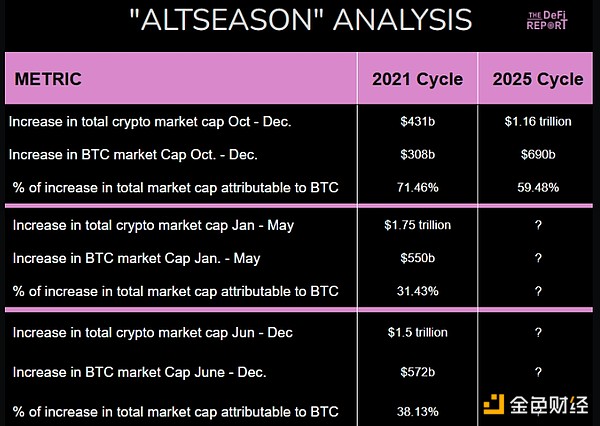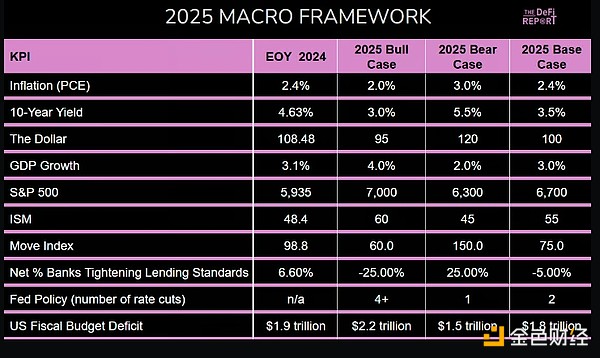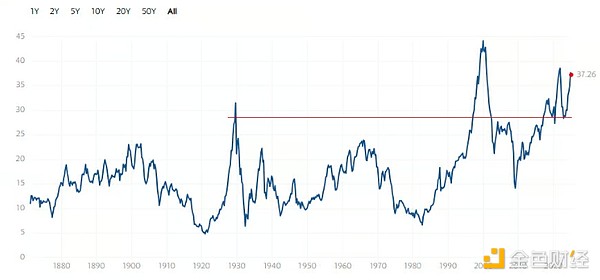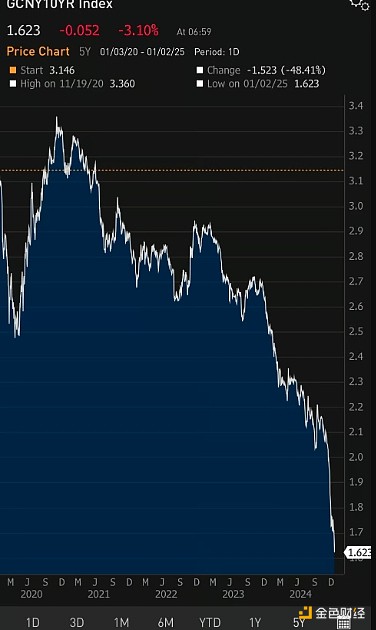Source: The Defi Report; Compiled by Wuzhu, Jinse Finance
2025 will be an important year. I am very pleased to share with you our data-driven analysis and market insights.
To welcome 2025, we will share our views on the "Altcoin season" and our current thoughts on macroeconomic issues for the coming year.
Has the Altcoin season arrived?
Given the outstanding performance of Solana in 2024, the meme coin frenzy, the revival of DeFi, and the recent rise of AI agents, some believe the "Altcoin season" has arrived.
We disagree. Why?
We believe Solana's outstanding performance is largely a rebound from being severely undervalued in 2023;
The meme frenzy looks more like the DeFi summer of 2020 (a glimpse of the impending bull market of 2021);
The revival of DeFi (Aave, Hyperliquid, Aerodrome, Pendle, Ethena, Raydium, Jupiter, Jito, etc.) is real, but DeFi still feels very niche. According to Kaito AI, its narrative share as an industry declined in 2024;
The rise of AI agents looks more like a glimpse of "Altcoin season" rather than the real thing.
We can acknowledge that there is a lot of bubble in the market. But the overall data doesn't lie.

Source: CoinGecko
Quick analysis:
In the previous cycle, the total cryptocurrency market cap grew by $431 billion in Q4 2020. Bitcoin accounted for 71.5% of the gain. BTC's dominance peaked at 72% on January 3, 2021.
In the current cycle, the total cryptocurrency market cap grew by $1.16 trillion in Q4. BTC accounted for 59.5% of the gain. BTC's dominance is currently at 56.4% - slightly below the cycle peak of 60% on November 21, 2024.
Now. You might think that BTC's smaller share of the total cryptocurrency market cap growth in this cycle means the Altcoin season has arrived.
But look at what happened as we entered 2021 (the final year of the previous cycle):
From January 1, 2021 to May 11, 2021, the crypto market cap grew by $1.75 trillion. BTC only accounted for 31% of the gain. Dominance dropped to 44%.
From May 11, 2021 to June 30, 2021, the total market cap fell nearly 50%. BTC fell around 50% in the same period.
The market then rebounded, reaching a peak of $3 trillion on November 8, 2021. BTC only accounted for 38% of the second wave of gains.
Key focus points:
While some believe this is "Bitcoin's cycle" (due to ETH underperformance, ETF dominance, strategic Bitcoin hoarding hype, L2s, etc.), the data shows that as we transition into 21 - the final year of the previous cycle - BTC is actually stronger.
In the previous cycle, as the new year arrived, the "Altcoin season" kicked off in grand fashion. From January to May, ETH rose 5.3x. Avalanche rose 12x. SOL rose 28x in the same period. DOGE rose 162x. This is the true face of the "Altcoin season". During this period, Bitcoin's dominance declined by nearly 30%.
As mentioned, we do see some bubbles in the market today. That said, we believe the "Altcoin season" is just getting started - the decline in Bitcoin's dominance from the cycle peak of 60% on November 21, 2024 is evidence of this.
We forecast the total cryptocurrency market cap to grow to $7.25 trillion next year (113% increase from today). If 35% of the capital flows into BTC from here, that would bring the total market cap to $3.2 trillion, or $162k BTC. Our bullish case forecasts the total crypto market cap at $10 trillion. If 35% of the capital flows into BTC, that would bring the total market cap to $4.2 trillion, or $212k BTC. Our bearish case forecasts the total market cap at $5.5 trillion. If 35% of the capital flows into BTC, that would bring the total market cap to $2.6 trillion, or $131k BTC.
We expect $2.5 trillion to flow into non-BTC assets this year - double that of the previous 2021 cycle. To put it another way: Solana, Avalanche and Terra Luna had a combined market cap of $677 million on January 1, 2021. They peaked at $146 billion by year-end. That's a 21,466% gain. Again. We haven't seen this kind of massive move before. This doesn't mean it has to happen.
There are several reasons for the emergence of the "Altcoin season". But we believe the main 4 drivers are:
1) The BTC wealth effect: BTC investors profiting + seeking greater returns on the risk curve.
2) Media attention. More attention = more users entering crypto. Many will invest in what they perceive as the "next Bitcoin".
3) Innovation. We typically see new and exciting use cases emerge in the later stages of a crypto cycle.
4) Macroeconomic/liquidity conditions/Fed policy - driving market sentiment and animal spirits.
Speaking of macroeconomic conditions...
If we want to have a proper "Altcoin season", we believe the macroeconomic and liquidity conditions must align with the growing risk appetite of market participants.
Macroeconomic Framework for 2025
In this section, we will analyze some key economic drivers of risk assets like cryptocurrencies, while contemplating the probabilities of various outcomes for 2025.

Inflation (PCE)
As we pointed out in our previous report, the Fed is concerned about inflation. As a result, they revised their rate hike forecast from 4 to 2 for this year at the November FOMC meeting. The market sold off as a result.
Our view on inflation:
We believe the Fed/market is taking a one-sided stance on the inflation issue. Why? The main drivers of inflation during COVID-19 were 1) supply chain issues, and 2) wartime printing (fiscal) + zero-rate policy (Fed).
So to forecast a resurgence in inflation, we need a catalyst. Some may point to oil. But we believe Trump's "drill baby drill" policy is deflationary for oil prices (increased supply should lead to price declines). Others point to fiscal spending and the projected $1.8 trillion deficit in 2025. Tax cuts, deregulation, tariffs - all fair game.
But we also have deflationary forces in our economy. Like AI and other technological innovations. Our population is aging - many baby boomers are retiring. Our population is also declining due to persistently low birth rates. We now have strict border policies.
These are all deflationary. Yet, some still believe inflation will "come roaring back" to 1970s levels. They make these comparisons without considering the differences in today's economy, demographics, commodity markets, etc.
Therefore, our base case forecast is for inflation to remain broadly within the range we see today (2.4% PCE). It may even decline. We believe this is favorable for risk assets, as it could lead to more than 2 rate cuts next year - which is not currently priced in.
10-Year Yield
The yield at the end of this year is 4.6% - a full 1% higher than on September 16, when the Federal Reserve began cutting rates. Therefore, the Federal Reserve is trying to ease monetary policy. But the bond market has tightened monetary policy. Why? We believe there are three main drivers:
Inflation. The bond market believes that the Federal Reserve's rate cuts could lead to a resurgence of inflation.
Concerns about fiscal spending and debt growth. The huge deficit is leading to an increase in government bond issuance - this could lead to an oversupply in the market. To attract buyers, interest rates must rise (unless the Federal Reserve intervenes as a buyer - we expect this to happen later this year).
Growth expectations. Due to Trump's policies (tax cuts, deregulation), the economy is expected to accelerate in 2025, which could lead to higher inflation.
Our view on interest rates:
We believe that given the above concerns, the bond market's repricing of the 10-year yield is fair. We note that the Treasury will need to refinance more than a third of all outstanding debt this year, much of it at the short end of the curve - where there are more buyers - and Secretary Yellen has done a lot of the refinancing in the previous cycle in advance. If the new Treasury Secretary, Scott Bessent, tries to pay down debt, it could create an imbalance between supply and demand at the long end of the curve, leading to a spike in yields.
We believe these risks are reasonable. But we also believe the Federal Reserve has tools (quantitative easing) to control the rise in yields when needed. We believe the Trump administration will do everything it can to boost asset prices.
We believe the 10-year yield will reach 3.5-4%. It may go lower. We reiterate that this is favorable for risk assets.
Growth and the S&P 500 Index
Although the Q4 data has not yet been released, the growth in the first three quarters indicates that our economic growth rate in 2024 will be 3.1%. The latest GDP Now forecast from the Atlanta Federal Reserve Bank shows a growth rate of 2.6% for next year.
Meanwhile, the S&P 500 index rose 25% last year and 24% this year. The CAPE ratio (a measure of valuation relative to inflation-adjusted earnings over the past 10 years) is currently 37.04, significantly higher than the historical average of 17.19, suggesting a potential mean reversion in 2025.
But we should not blindly assume that mean reversion is imminent. What if lower taxes and deregulation increase incomes? What if automation improves efficiency? Or the expectation of these things prompts market participants to buy stocks?
Notably, the CAPE ratio bottomed in October 2022, approaching the peak valuation levels of 1929 (on the eve of the Great Depression). We believe the nature of the modern global liquidity cycle may be distorting asset valuations - especially after the 2008 financial crisis. After all, governments around the world continue to print money to mask the problem of population aging - creating asset bubbles in the process and spawning more and more zombie companies.

Data: DeFi report, S&P 500 CAPE ratio (from multpl.com)
Our view on growth and the S&P 500 index:
We believe this year's data may surprise on the upside. But it largely depends on whether Trump can push through Congress with tax cuts and deregulation.
That said, we do not believe a recession is imminent. Although the CAPE ratio is high, we also do not believe we are in a bubble. Our base forecast is for the S&P 500 index to grow 12.8% this year.
Short-term outlook:
The labor market is cooling, with the unemployment rate at 4.3% (higher than last year's 3.6%). The ISM index is at 48.4, indicating a moderate contraction in manufacturing (11% of GDP). At the same time, the Federal Reserve has cut rates 3 times, with the easing cycle reaching 1%. The market currently expects a pause in rate hikes in January, with an 88% chance of a rate cut. There is no FOMC meeting in February.
Therefore, the federal funds rate appears likely to remain at 4.25-4.5% at the earliest until before March. Additionally, the debt ceiling debate is looming, as Secretary Yellen has stated that the Treasury will reach the borrowing limit between January 14 and January 23. Therefore, we believe the Treasury may have to tap the TGA - the Treasury's operating account at the Federal Reserve, which can be used in emergencies. This account currently has about $700 billion. The Federal Reserve can also use reverse repo tools to release liquidity in an emergency.

Therefore, we believe the first quarter may see some volatility, ultimately leading to liquidity injections by the Federal Reserve/Treasury. We expect some short-term fluctuations.
Conclusion
We believe the "Altcoin season" has just begun. But we also believe that macroeconomic and global liquidity conditions need to support the proper rotation of Altcoins this year.
Of course, the macroeconomic outlook is difficult to predict. But we hope our analysis can help you develop your own framework to understand how this year might unfold.
We believe there is no risk of rate hikes - the last rate hike cycle ended in November 2021;
We believe there is no risk of a recession in the future (although some sectors like commercial real estate are still experiencing pain);
We believe the Federal Reserve/market is offside on the inflation issue;
We believe the labor market may show further signs of weakness in the first quarter;
We believe yields will decline later this year, and the Federal Reserve may purchase U.S. Treasuries (quantitative easing) while lowering rates;
We still believe there are upside risks this year, as we believe Trump's market environment in the era of rapid technological progress is similar to the late 1990s;
As the debt ceiling debate unfolds in the coming weeks, we expect some volatility/dramatic events;
The biggest risk is a black swan event, which would force the Federal Reserve to cut rates quickly, as the market may panic and sell, only to be ultimately buoyed by liquidity.





